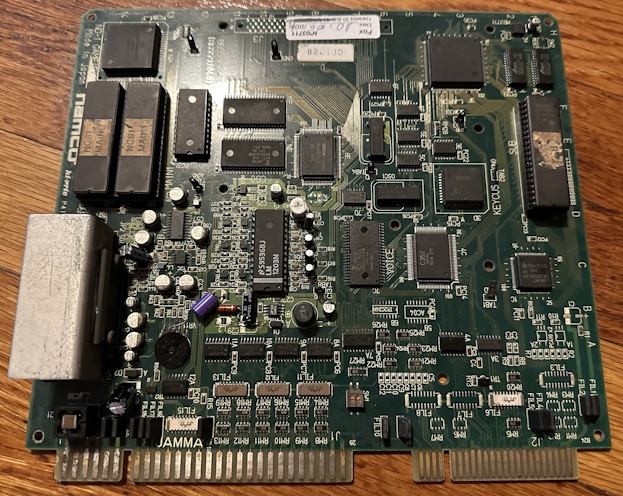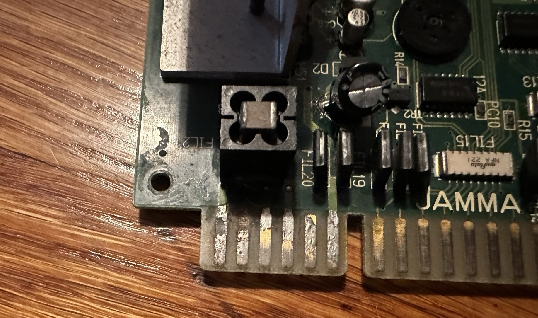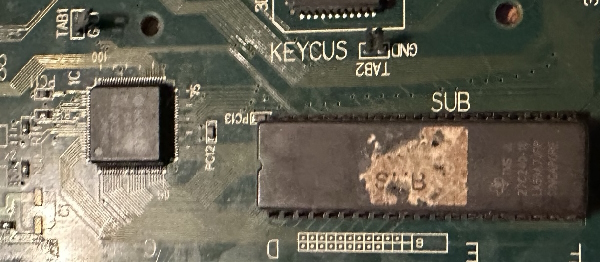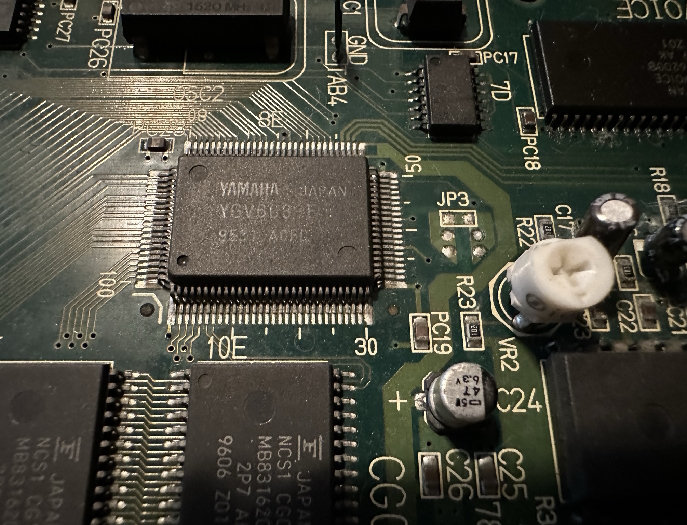The Namco ND-1: Taking 2D for Granted
Last year, I covered the CAVE CV-1000, an early-2000’s arcade platform that was the last gasp of dedicated 2D hardware, with a RISC CPU and a blitter. But that was to power fast-paced “bullet hell” shooters with huge numbers of moving objects each frame, where even slowdown is crucial to strategy. What if your aims were a bit more… pedestrian? What if all you wanted was to make some 80’s games on cheaper hardware?
Collectathon
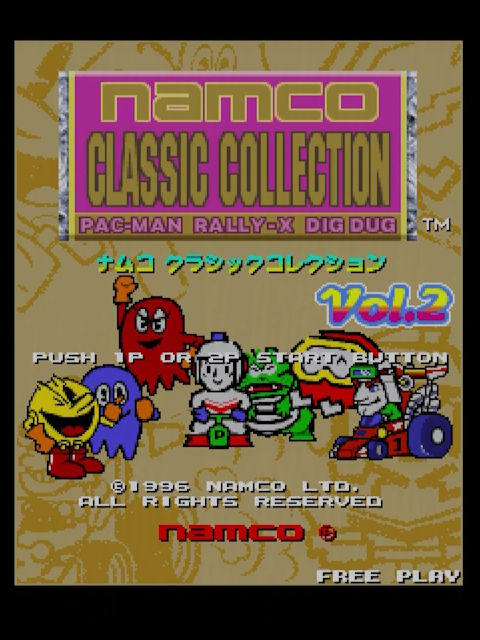
We’re over a decade before the heyday of CAVE, and looking at Namco’s Namco Collection Vol. 2. It’s a remake collection of Dig Dug, Pac-Man, and Rally-X (also features New Rally-X), with both original and new “arrange” versions. These are big enough titles that it’s possible the two games in the Namco Collection series (Vol. 1 had Mappy, Xevious, and Galaga) outsold all of the CAVE games. That’s the difference between a hardcore niche and the mass-market.

There was a western release, but my copy is Japanese. I’m going to be totally honest and say I consider myself lucky to have this board; this game often goes for a lot of money. It’d be nice if there was a language DIP switch setting, but there isn’t. Maybe one day I’ll break this board by trying to rewrite all the ROMs.

Speaking of DIP switches, the “SERVICE” button on this system has the odd behavior that the service menu only remains open as long as you hold it down, rather than simply pressing it. I’m guessing it’s sending the same signal as the DIP switches do; this board has just two switches, one for test and one for freeze, nothing game-specific as that’s all in the menu system.
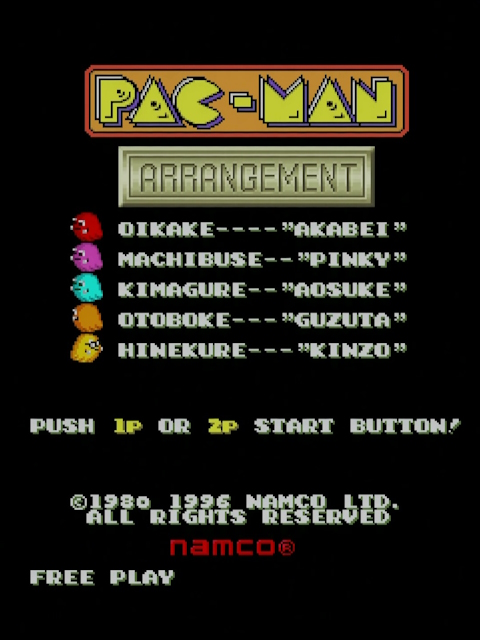
My main interest in this board was for Pac-Man Arrangement; I had this game as a kid, not as an arcade cabinet, but as part of the 2001 Pac-Man Collection pack for Game Boy Advance. So it’s pretty cool to have the full-screen tate mode version. The near-perfect original ports and arrange versions for the other games are definitely a nice bonus.

Nota bene: This isn’t the NB-1
Behold: the Namco ND-1. A fairly compact board, used only by the two Namco Collection games as well as, according to MAME, a game called Abnormal Check, which I’ve never heard of, but from the title screen definitely appears to be abnormal.
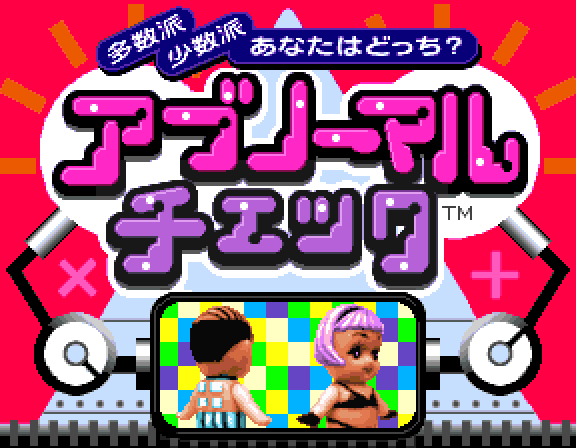
You might also notice that the power portion of the JAMMA connector is in very rough shape. This is actually after my best efforts to clean it up; the board does work, and the power pins on the other side are in good shape, so let’s ignore that for now.
So, it’s 1995. This is an interesting point in history: 2D video games like Pac-Man are very much old hat. But unlike the pirates of a decade or so later, you also can’t just get a cheap board with a powerful 32-bit ARM chip. So what do you do? Well, you’re making an arcade board. So you break out the Motorola 68000. This may have been mandatory at this point.
It’s 1995, so you can run it at a comfortable 12.288MHz. It’s no 20MHz PolyGame Master, but it’ll do. It’s paired with a Hitachi H8 microcontroller. You might’ve been expecting a Z80, but no! This is apparently a custom Hitachi architecture with its roots in the PDP-11, making this the logical successor to the Mattel Intellivision. It has an ADC (that is hooked up but unused) and is hooked up to the Namco C354 custom sound chip, so it’s pretty similar to the roles we’ve seen Z80 coprocessors play.
You might be surprised that even though this is reported as a microcontroller, this particular chip does have an external ROM. The word “microcontroller” isn’t exactly well-defined.
Yamaha strikes again
What I find most interesting here is the Yamaha YGV-608. Given its location next to a variable resistor and a bunch of passives, and the Yamaha branding, you might expect it to be a sound chip. Not so! That’s the Namco-custom “C354”.
So what is the YGV-608? It’s the video chip, the Yamaha “Pattern mode Video Display Controller 2”! Now, Yamaha definitely has made their fair share of VDPs by this point, including the Sega Genesis, the VDP powering the MSX2 series of computers, and several others. But it’s still not something I’ve seen on an arcade board before.
The feature list from the datasheet, which also promises 2 “pattern graphics” planes and 64 sprite planes, is quite interesting, if a bit unclear at times:
- Two screens having a maximum size of 4096 x 4096 dots (display area size can be changed in 512 x 2n units) can be constructed simultaneously
- Pattern size can be selected from among 8 x 8, 16 x 16, 32 x 32, and 64 x 64 dots.
- Two 64 x 32 pattern (1 page) pattern name table RAMS are built-in.
- 32 pages can be linked and displayed.
- Pattern generator selection RAM for 32 pages is built-in and can be selected from among 64 pattern generators for each page.
- Maximum number of patterns that can be selected is 4096 for each pattern.
- Color pallet can be selected for each pattern.
- Each pattern can be reverse displayed vertically and horizontally.
- Because a vertical scroll data RAM and horizontal scroll data RAM are built in, smooth scrolling is easy.
- Divided screen can be scrolled in pattern units.
- Screen can be divided into 32 horizontal and 64 vertical windows.
- 16 built-in 16-color palette of display, selectable from among 260,000 colors. 256 colors can be displayed from among 260,000 colors.
- External pattern generator ROM can be connected up to maximum 2 M bytes.
- Mosaic display function
- Zoom compression and rotation display functions
At first, I wondered if this had anything to do with the Yamaha V9990, which was supposedly what survived of the planned MSX3 VDP. But they don’t actually seem that similar. It does seem like a pretty nice VDP, though; MAME’s implementation only covers what’s necessary for Namco’s games, so is missing things like scaling and rotation.
Games that are always relevant?

In the arcades, Namco’s often credited with the creation of the “standard” tilemap and sprites combination with their landmark 1979 title Galaxian. With its colorful, smoothly moving objects, it’s an impressive step up over Taito’s Space Invaders.
And so Namco has often had reason to go back to the retro world. I don’t think anyone will be surprised to hear that the Namco ND-1 was not the last of its kind. In 2001, Namco released the Class of 1981 Reunion cabinet, featuring the two 1981 hits Ms. Pac-Man and Galaga, which were both definitely created solely by Namco.
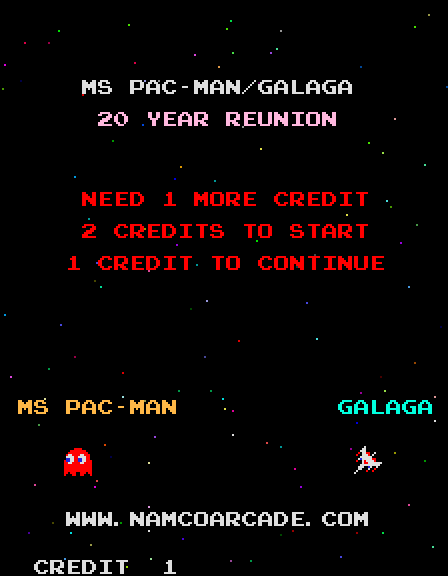
I don’t have this board. But it seems from the MAME reverse engineers that this is also a tilemap/sprite hardware, built into two CPLD chips and powered by an 8-bit Z180 CPU. Note that this release didn’t have any of the arrange modes, just straight ports of the 1981 games (which used a Z80). That one was such a hit that Banco Namdai still sells parts.
As for the modern Pac-Man’s Pixel Bash nostalgia cabinets, I’d be stunned if they weren’t doing emulation, but I don’t have one to find out and the publically-available manual doesn’t elucidate much about that. But it does explain something else:

The TEST and SELECT controls are not buttons, but toggle switches. I assume they must have been on the cabinets the Namco Classic Collection Vol. 2 board was intended for as well; hence why I have to “hold the button down” on my supergun. Interesting!

